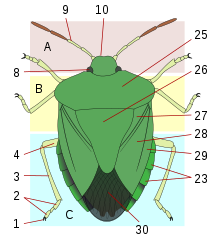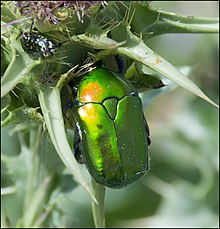Scutoid: Difference between revisions
m →Naming: reference should emphasize the author and article, not the journal it was published in. Also, citing the actual open access article, not the Eureka alerts news-service. |
Scutoid Sculpture, Curved Scutoids, and scutellum outlined on beetle |
||
| Line 3: | Line 3: | ||
[[File:Heteroptera morphology-d.svg|thumb|26=[[Scutellum (insect anatomy)|scutellum]] on [[Heteroptera]]]] |
[[File:Heteroptera morphology-d.svg|thumb|26=[[Scutellum (insect anatomy)|scutellum]] on [[Heteroptera]]]] |
||
{{external media |
|||
| float = right |
|||
| width = 200px |
|||
| image1 = [https://boygeniusreport.files.wordpress.com/2018/08/screen-shot-2018-08-01-at-1-33-16-pm.png?w=782 Scutoid Sculpture, <br>Curved Scutoids, and <br>scutellum outlined on beetle]<ref>{{cite web|url=https://bgr.com/2018/08/01/scientists-discovered-a-completely-new-shape-hiding-in-our-cells/|title=Scientists discovered a completely new shape hiding in our cells|first=Mike|last=Wehner|date=1 August 2018|website=bgr.com|accessdate=3 August 2018}}</ref> |
|||
}} |
|||
==Naming== |
==Naming== |
||
Revision as of 18:05, 4 August 2018

A scutoid is a geometric solid between two parallel surfaces. The boundary of each of the surfaces (and of all the other parallel surfaces between them) is a polygon, and the vertices of the two end polygons are joined by either a curve or a Y-shaped connection. Scutoids present at least one vertex between these two planes. Scutoids are not necessarily convex, and lateral faces are not necessarily planar, so several scutoids can pack together to fill all the space between the two parallel surfaces.[1][2]

| External image | |
|---|---|
Curved Scutoids, and scutellum outlined on beetle[3] |
Naming
The object was first described by Gómez-Gálvez et al. in a paper entitled Scutoids are a geometrical solution to three-dimensional packing of epithelia, and published 27 July 2018[1]. The name scutoid was coined because of its resemblance to the shape of the scutum and scutellum in some insects, such as beetles in the Cetoniidae subfamily.[1] Clara Grima has stated that while working on the project, the shape was called an escutoid as a joke after the biology group leader Luis M. Escudero,[4][5] since his lastname "Escudero" means "Squire" and shield in Latin is "scutum", thus they coined "scutoid".
Appearance in nature
The shape, however odd, is a building block of multicellular organisms; complex life might never have emerged on Earth without it.
— Alan Burdick, We Are All Scutoids: A Brand New Shape, Explained[2]

Epithelial cells adopt the "scutoidal shape" under certain circumstances.[1] In epithelia, cells can 3D-pack as scutoids, facilitating tissue curvature. This is fundamental to the shaping of the organs during development.[1][6][7]
"Scutoid is a prismatoid to which one extra mid-level vertex has been added. This extra vertex forces some of the "faces" of the resulting object to curve. This means that Scutoids are not polyhedra, because not all of their faces are planar. ... For the computational biologists who created/discovered the Scutoid, the key property of the shape is that it can combine with itself and other geometric objects like frustums to create 3D packings of epithelial cells."
- Laura Taalman[8][9]
References
- ^ a b c d e Gómez-Gálvez, Pedro; Vicente-Munuera, Pablo; Tagua, Antonio; Forja, Cristina; Castro, Ana M.; Letrán, Marta; Valencia-Expósito, Andrea; Grima, Clara; Bermúdez-Gallardo, Marina (2018-07-27). "Scutoids are a geometrical solution to three-dimensional packing of epithelia". Nature Communications. 9 (1). doi:10.1038/s41467-018-05376-1. ISSN 2041-1723.
- ^ a b Burdick, Alan (July 30, 2018). "We Are All Scutoids: A Brand-New Shape, Explained". The New Yorker. Retrieved 2018-08-03.
- ^ Wehner, Mike (1 August 2018). "Scientists discovered a completely new shape hiding in our cells". bgr.com. Retrieved 3 August 2018.
- ^ standupmaths (3 August 2018). "THE SCUTOID: did scientists discover a new shape?". Retrieved 3 August 2018 – via YouTube.
- ^ https://static-content.springer.com/esm/art%3A10.1038%2Fs41467-018-05376-1/MediaObjects/41467_2018_5376_MOESM3_ESM.avi
- ^ Boddy, Jessica. "The 'Scutoid' Is Geometry's Newest Shape, and It Could Be All Over Your Body". Gizmodo. Retrieved 2018-07-29.
- ^ "Scientists have discovered a brand-new three-dimensional shape". Newsweek. 2018-07-27. Retrieved 2018-07-29.
- ^ Laura Taalman @mathgrrl (28 July 2018). "Have you read the @Nature article introducing the new mathematical shape called the SCUTOID? This cutting-edge science is now 3D printable". twitter.com. Retrieved 3 August 2018.
- ^ Inc., Shapeways. "Pair of Packable Scutoids by mathgrrl on Shapeways". Shapeways.com. Retrieved 3 August 2018.
{{cite web}}:|last=has generic name (help)
External links
